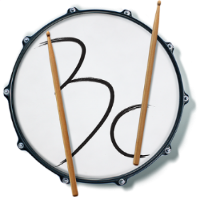How Drums Have Changed Over Time
by Josh Merhar
For the most part, instrument manufacturers have created standard sizes and shapes for drums. But many efforts to "improve" the standard drum shell have been made over the years, resulting in some really interesting ideas that didn't quite catch on and withstand the test of time. Let's take a look at some of these creations...
Trixon Drums: 1950s - 1970s
During the late 1950s, the German-based Trixon Drums began producing ellipsoidal bass drums with their Speedfire series (pictured below). These funny looking blob-esque drums were designed to host two kick pedals -- one toward the larger part of the drum for a lower pitch and beefier sound, and another near the smaller part of the drum for a higher pitch and more delicate sound. A partition inside the bass drum divided the separate sections. The Trixon Speedfire never really gained mainstream traction globally. The egg-shaped bass drums were difficult to craft and expensive to manufacture. Imagine trying to buy new heads! Trixon also produced another intriguing line of drums, known as the Telstar series. Telstar drums featured conical shells, which tapered from a larger diameter to a smaller diameter. Hitting different ends of the drums would produce different pitches. The larger side produced lower pitches while the smaller side produced higher pitches. Unable to compete with larger manufacturers from the U.S. and Asia, Trixon stopped making drums 1973.
Staccato Drums: 1970s
In the late 1970s, Staccato Drums (pictured below) began producing wildly shaped fiberglass drum shells that resembled a melting horn. Designed to compete with the volume of amplified instruments without the need to place microphones on all the drums, these shells allow for crystal-clear articulation and projection, resulting in a gratuitous amount of volume. In other words, they are LOUD. While Staccato drums have gained a cult following over the years, their price point dissuades most casual players and their shape makes storing and transporting them quite difficult. Staccato drums are still produced to this day. You can order your very own custom Staccato drum kit by placing an order on their website.
Different Shapes of Cymbals Over Time
Some instrument manufacturers, to varying degrees of success, even attempted to change the shape of cymbals. Sabian produced a short run of their Rocktagon series cymbals in the mid 2000s, which were trimmed into an octagonal shape. They never gained much popularity and ceased production before 2010. Sabian wasn't alone in its quest to innovate cymbal design. Zildjian created a prototype square ride cymbal for Thomas Pridgen, but the design never made it to the retail market. Practically no information could be found about this oddity aside from a picture, posted by Thomas Pridgen on FaceBook in 2011 (seen below), which confirms its existence. One could only assume the cost and effort to produce square cymbals far outweighed the demand. Perhaps the shape resulted in an unstable and fragile structure unable to endure constant striking. But that's all pure speculation
Drums of the Future
While physical innovations seemed to have stagnated a bit, the next new trend in percussion instrument design could be right around the corner. The ever-changing needs of the music industry will surely spark the inspiration for some ingenious designs in the future.
All of our instructors here at Boston Drum Lessons draw from years of experience studying, playing, and performing on the drums in every capacity imaginable. Interested in starting your drumming journey or taking your skills to the next level? Schedule a trial lesson to get closer to your goals!




